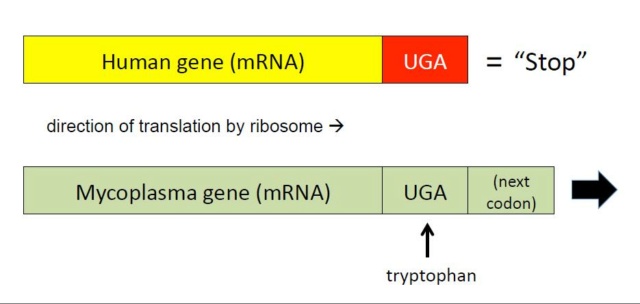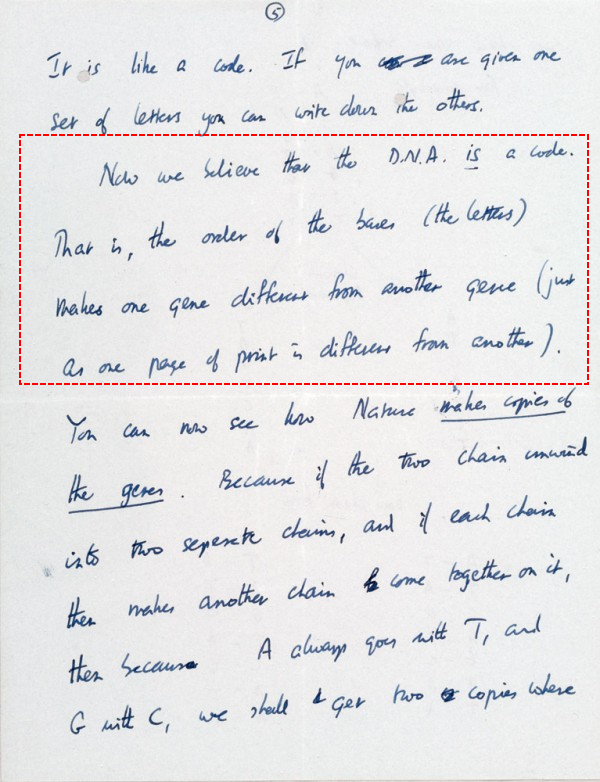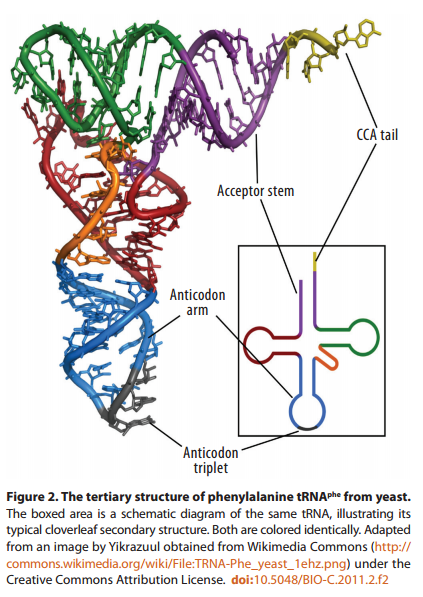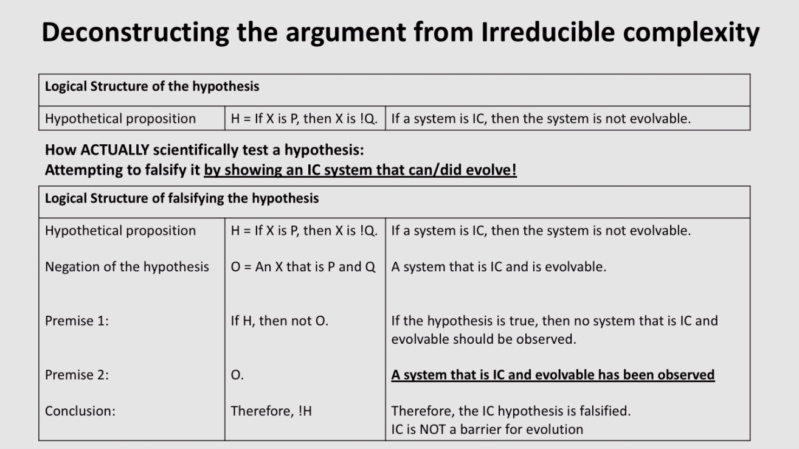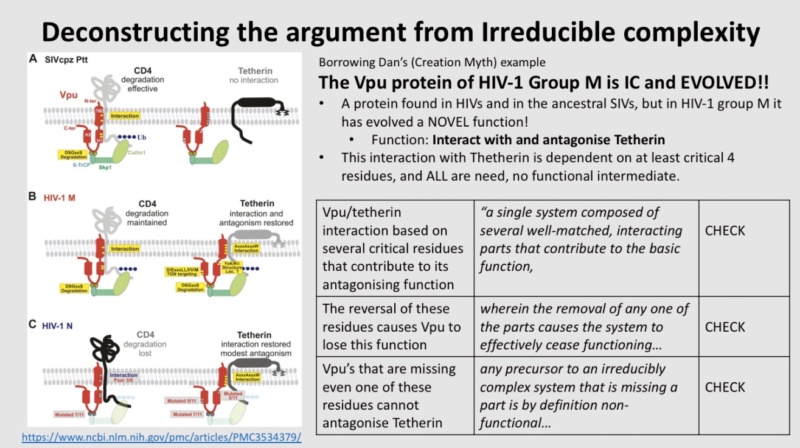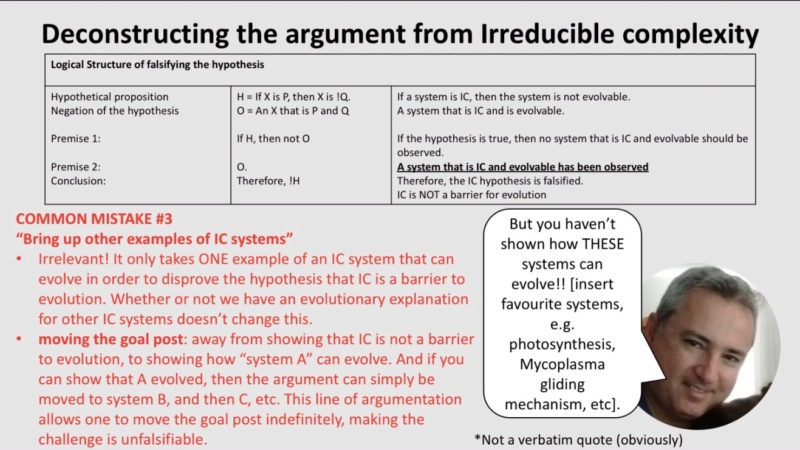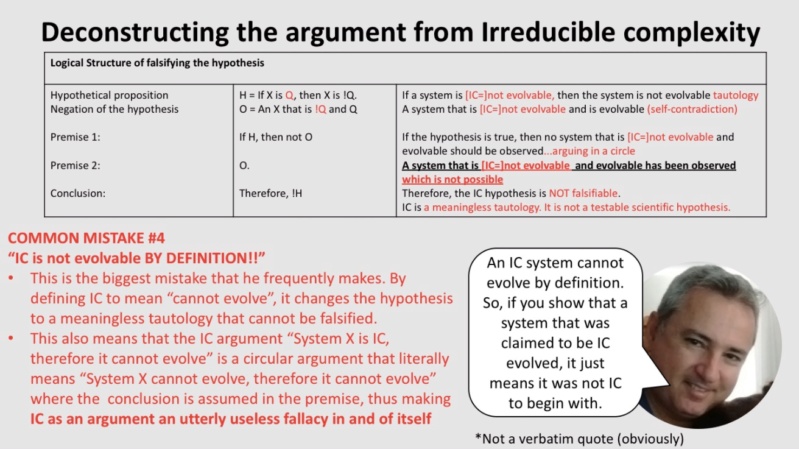This e-mail list was started to exchange scientific information that either instantiates intelligent designer(s)/God(s) or not. Anyone can participate. When replying, please reply to all. Representatives of both sides are included in the list. New participants can be added by anyone. If you do not wish to receive the e-mails, you can block and unfollow.
DK: The better explanation is the formation of the bridge peptide.
In your paper, you state: We assume that the factor determining the time of encoding of a particular amino acid could only be its physicochemical properties related to the survival of the living structures.
In the conclusion of your paper, you write: : the amino acids that possess GC-rich codons were the very first to be included in the initial living complex.
Question: What living complex was that, if life depends on the full set up of the genetic code, ( and all tRNA's, mRNA, the ribosome, aminoacyl tRNA synthetase, etc? https://mmbr.asm.org/content/68/3/518 )
At point 4. you write: Order of Codon Establishment—GC-Rich Were Early and AU Late
I don't get how you conclude that GC would be early, and AU late, in face of what I already replied: DNA’s capacity to convey information actually requires freedom from chemical determinism or constraint, in particular, in the arrangement of the nucleotide bases. If the bonding properties of nucleotides determine their arrangement, the capacity of DNA to convey information would be destroyed. In that case, the bonding properties of each nucleotide would determine each subsequent nucleotide and thus, in turn, the sequence of the molecular chain. Under these conditions, a rigidly ordered pattern would emerge as required by their bonding properties and then repeat endlessly, forming something like a crystal. If DNA manifested such redundancy, it would be impossible for it to store or convey function bearing information. Whatever may be the origin of a DNA configuration, it can function as a code only if its order is not due to the forces of potential energy. It must be as physically indeterminate as the sequence of words is on a printed page.
Please elucidate.
DK: “The selection” and “unguided means” those two terms are used not correctly. The selection is the guide toward survival.
Reply: There was no survival. We are talking about things prior to when life started. Life is characterized in my understanding as done by Davies:
https://reasonandscience.catsboard.com/t1435-paul-davies-what-is-life
DK:Also, the new formed Darwinian selection (evolution) was formed at the level of already formed short RNA and peptides. Until that moment you have just chemistry. Although some blocks of life may be more stable this is not information-based selection = life.
Reply: Koonin, the logic of chance, page 246 Evolution by natural selection and drift can begin only after replication with sufficient fidelity is established.
DK: RNA building blocks and RNA is quite stable especially in acidic conditions. I can boil RNA and will stay intact (proven thousands of times). Also, what kind of argument is this? Just a recent paper from prof Williams shows that RNA is even more stable with peptide interactions.
Reply: Nucleic acid instability challenges RNA world hypothesis 26 SEPTEMBER 2016
RNA and DNA have very different abilities to withstand chemical changes like depurination, deamination, and hydrolysis. The chemical stability of these two nucleic acids should also be considered when thinking about how they could become incorporated into the earliest forms of life.
https://www.chemistryworld.com/news/nucleic-acid-instability-challenges-rna-world-hypothesis/1017458.article
The stability of the RNA bases: Implications for the origin of life MATTHEW LEVY AND STANLEY L. MILLER , July 1998
High-temperature origin-of-life theories require that the components of the first genetic material are stable. We, therefore, have measured the half-lives for the decomposition of the nucleobases. They have been found to be
short on the geologic time scale. At 100°C, the growth temperatures of the hyperthermophiles, the half-lives are too short to allow for the adequate accumulation of these compounds (t1/2 for A and G ~ 1 yr; U = 12 yr; C = 19 days).
Therefore, unless the origin of life took place extremely rapidly (<100 yr), we conclude that a high-temperature origin of life may be possible, but it cannot involve adenine, uracil, guanine, or cytosine.
https://www.pnas.org/content/pnas/95/14/7933.full.pdf
PREBIOTIC RIBOSE SYNTHESIS: A CRITICAL ANALYSIS ROBERT SHAPIRO d 9 February, 1987
The evidence that is currently available does not support the availability of ribose on the prebiotic earth, except perhaps for brief periods of time, in low concentration as part of a complex mixture, and under conditions unsuitable for nucleoside synthesis.
https://sci-hub.st/https://link.springer.com/article/10.1007/BF01808782
Robert Shapiro:
The presumption that “the bases, adenine, cytosine, guanine and uracil were readily available on the early earth” is “not supported by existing knowledge of the basic chemistry of these substances. The RNA-world hypothesis faces an even more acute, but related, obstacle—a kind of catch-22. The presence of the nitrogen-rich chemicals necessary for the production of nucleotide bases prevents the production of ribose sugars. Yet both ribose and the nucleotide bases are needed to build RNA.
Dean Kenyon explains
“The chemical conditions proposed for the prebiotic synthesis of purines and pyrimidines [the bases] are sharply incompatible with those proposed for the synthesis of ribose.”
Shapiro concludes:
“The evidence that is currently available does not support the availability of ribose on the prebiotic earth, except perhaps for brief periods of time, in low concentration as part of a complex mixture, and under conditions unsuitable for nucleoside synthesis.”
Ot: “Ribozymes Are Poor Substitutes for Proteins” DK: Please accept my apology for the note, but what is this? Argument or joke? There are so many different proteins with a variety of activities including interaction with RNA. Frankly, I have no idea where you are going with this argument!
Reply: Naturally occurring RNA molecules possess very few of the specific enzymatic properties of proteins. Science has shown that ribozymes can perform a few of the inumerous functions performed by proteins. Some RNA molecules can cleave other RNA molecules (at the phosphodiester bond) (hydrolysis). Ribosomal (rRNA) performs peptide-bond formation in the peptidyl transferase center, though only in association with an additional chemical catalyst. Beyond that, RNA can perform only a few minor functional roles and then usually as the result of engineering in the laboratory. Claiming that catalytic RNA could replace proteins in the earliest stages of chemical evolution is not evidence-based.
Ot: “An RNA-based Translation and Coding System Is Implausible” DK: Just the biological process “Translation” means transfer of information from RNA to protein. Of course, if you have only RNA there will not be a translation by default. I’m assuming, you refer to the RNA world hypothesis which has to explain the transition from RNA only system to RNA-protein system. I agree it is difficult by the RNA world hypothesis.
Reply: How do you go from an RNA based world, to produce proteins? That is a huge, unsolved gap. In order to do so, you need the molecular machines that do so. The primitive replicator would need to produce RNA molecules capable of performing the functions of proteins involved in translation.
Determination of the Core of a Minimal Bacterial Gene Set
A bacterial cell depends upon a translation and coding system consisting of 106 distinct but functionally integrated proteins as well several distinct types of RNA molecules (tRNAs, mRNAs, and rRNAs) The minimal number of ribosomal proteins required for proper functioning of the ribosome corresponds to the gene set present in M. genitalium, which includes 31 proteins for the large ribosomal subunit and 19 proteins for the small one.
https://mmbr.asm.org/content/68/3/518
These RNA molecules would need to perform the functions of the twenty specific tRNA synthetases, tRNA's, among the many others involved in translation.
How do you go to substitute supposed ribozymes with proteins, that later would do the same job? That's a far fetched just so scenario, which bears no evidence that such a transition could/would occur. In other words, the evolving RNA world would need to develop a coding and translation system based entirely on RNA and also generate the information necessary to build the proteins that later would be needed to replace it.
Ot: “The RNA World Doesn’t Explain the Origin of Genetic Information” DK: What do you mean? Genetic information or genetic code. Actually, the RNA world explains well the origin of stable RNA sequences (information) but has difficulties to explain genetic code. Yes, I agree indeed RNA world hypothesis have a huge difficulty to explain origin of genetic code or the process of polymer transition. HOWEVER, OTANGELO NONE OF MY PAPERS ADVOCATES RNA WORLD HYPOTHESIS BUT RNA-PEPTIDE WORLD HYPOTHESIS AND THIS IS VERY DIFFERENT. It looks like that you do not make differences between those two different types of hypotheses. My view is that the RNA world hypothesis is a history.
Reply:1. Algorithms, prescribing functional instructions, digital programming, using symbols and coding systems are abstract respresentations and non-physical, and originate always from thought—from conscious or intelligent activity.
2. Genetic and epigenetic information is characterized containing prescriptive codified information, which result in functional outcomes due to the right particular specified complex sequence of triplet codons and ultimately the translated sequencing of amino acid building blocks into protein strings. The sequencing of nucleotides in DNA also prescribes highly specific regulatory micro RNAs and other epigenetic factors.
3. Therefore, genetic and epigenetic information comes from an intelligent mind. Since there was no human mind present to create life, it must have been a supernatural agency.
https://biosemiosis.net/?fbclid=IwAR1xTZ-JWsSeSaTHqN5MmsaXpPN6dlFQz4liWCcOYzt6ugib-TVWv9y8YIE
Information is not a tangible entity, it has no energy and no mass, it is not physical, it is conceptual.
- Life is a software / information driven process.
- Information is not physical it is conceptual.
- The only known source of semiotic information is prior intelligence.
- Life is therefore the direct product of a deliberate creative intellectual processes.
Semiotic functional information is not a tangible entity, and as such, it is beyond the reach of, and cannot be created by any undirected physical process.
This is not an argument about probability. Conceptual semiotic information is simply beyond the sphere of influence of any undirected physical process. To suggest that a physical process can create semiotic code is like suggesting that a rainbow can write poetry... it is never going to happen! Physics and chemistry alone do not possess the tools to create a concept. The only cause capable of creating a conceptual semiotic information is a conscious intelligent mind.
Life is no accident, the vast quantity of semiotic information in life provides powerful positive evidence that we have been designed.
To quote one scientist working at the cutting edge of our understanding of the programing information in biology, he described what he saw as an “alien technology written by an engineer a million times smarter than us”
DK: Here we go again “irreducible complexity” and our friend Otangelo. Please, stop it and try to understand the living systems (organisms or cells or whatever) evolved in a step by step co-evolution upgrade.
Reply: This is your claim. There is no evidence to back it up.
DK: Every single moment whatever is built is self sufficient for the ALREADY existing system. Every single bio-process can be reconstituted outside of the cell. If I accept your argument for “irreducible complexity” I have to accept also that there is not in existence simpler and more complicated organisms and all organisms are with the same level of complexity. YOU KNOW, I KNOW, EVERYBODY KNOWS THAT IS NOT CORRECT. Otangelo, that was the last time that I’m explaining “irreducible complexity” not anymore.
Reply: Michael Behe's Original Definition — [an irreducibly complex system is] "a single system composed of several well-matched, interacting parts that contribute to the basic function of the system, wherein the removal of any one of the parts causes the system to effectively cease functioning." (Darwin's Black Box, page 39, 1996)
This means, before starting an inquiry if a complex system ( biological or not ) is irreducible, we need to set the minimal target function. In our case, it is LIFE. If you disagree, then we should be able to reduce the complexity of Pelagibacter ubique to a bunch of subatomic particles, which should be able to perform the same basic functions as a prokaryotic cell. That will of course not gonna happen. The threshold
Denton: Evolution, A Theory in Crisis, page 249
We now know not only of the existence of a break between the living and non-living world but also that it represents the most dramatic and fundamental of all the discontinuities of nature. Between a living cell and the most highly ordered non-biological system, such as a crystal or a snowflake, there is a chasm as vast and absolute as it is possible to conceive.
DK: The better explanation is the formation of the bridge peptide.
In your paper, you state: We assume that the factor determining the time of encoding of a particular amino acid could only be its physicochemical properties related to the survival of the living structures.
In the conclusion of your paper, you write: : the amino acids that possess GC-rich codons were the very first to be included in the initial living complex.
Question: What living complex was that, if life depends on the full set up of the genetic code, ( and all tRNA's, mRNA, the ribosome, aminoacyl tRNA synthetase, etc? https://mmbr.asm.org/content/68/3/518 )
At point 4. you write: Order of Codon Establishment—GC-Rich Were Early and AU Late
I don't get how you conclude that GC would be early, and AU late, in face of what I already replied: DNA’s capacity to convey information actually requires freedom from chemical determinism or constraint, in particular, in the arrangement of the nucleotide bases. If the bonding properties of nucleotides determine their arrangement, the capacity of DNA to convey information would be destroyed. In that case, the bonding properties of each nucleotide would determine each subsequent nucleotide and thus, in turn, the sequence of the molecular chain. Under these conditions, a rigidly ordered pattern would emerge as required by their bonding properties and then repeat endlessly, forming something like a crystal. If DNA manifested such redundancy, it would be impossible for it to store or convey function bearing information. Whatever may be the origin of a DNA configuration, it can function as a code only if its order is not due to the forces of potential energy. It must be as physically indeterminate as the sequence of words is on a printed page.
Please elucidate.
DK: “The selection” and “unguided means” those two terms are used not correctly. The selection is the guide toward survival.
Reply: There was no survival. We are talking about things prior to when life started. Life is characterized in my understanding as done by Davies:
https://reasonandscience.catsboard.com/t1435-paul-davies-what-is-life
DK:Also, the new formed Darwinian selection (evolution) was formed at the level of already formed short RNA and peptides. Until that moment you have just chemistry. Although some blocks of life may be more stable this is not information-based selection = life.
Reply: Koonin, the logic of chance, page 246 Evolution by natural selection and drift can begin only after replication with sufficient fidelity is established.
DK: RNA building blocks and RNA is quite stable especially in acidic conditions. I can boil RNA and will stay intact (proven thousands of times). Also, what kind of argument is this? Just a recent paper from prof Williams shows that RNA is even more stable with peptide interactions.
Reply: Nucleic acid instability challenges RNA world hypothesis 26 SEPTEMBER 2016
RNA and DNA have very different abilities to withstand chemical changes like depurination, deamination, and hydrolysis. The chemical stability of these two nucleic acids should also be considered when thinking about how they could become incorporated into the earliest forms of life.
https://www.chemistryworld.com/news/nucleic-acid-instability-challenges-rna-world-hypothesis/1017458.article
The stability of the RNA bases: Implications for the origin of life MATTHEW LEVY AND STANLEY L. MILLER , July 1998
High-temperature origin-of-life theories require that the components of the first genetic material are stable. We, therefore, have measured the half-lives for the decomposition of the nucleobases. They have been found to be
short on the geologic time scale. At 100°C, the growth temperatures of the hyperthermophiles, the half-lives are too short to allow for the adequate accumulation of these compounds (t1/2 for A and G ~ 1 yr; U = 12 yr; C = 19 days).
Therefore, unless the origin of life took place extremely rapidly (<100 yr), we conclude that a high-temperature origin of life may be possible, but it cannot involve adenine, uracil, guanine, or cytosine.
https://www.pnas.org/content/pnas/95/14/7933.full.pdf
PREBIOTIC RIBOSE SYNTHESIS: A CRITICAL ANALYSIS ROBERT SHAPIRO d 9 February, 1987
The evidence that is currently available does not support the availability of ribose on the prebiotic earth, except perhaps for brief periods of time, in low concentration as part of a complex mixture, and under conditions unsuitable for nucleoside synthesis.
https://sci-hub.st/https://link.springer.com/article/10.1007/BF01808782
Robert Shapiro:
The presumption that “the bases, adenine, cytosine, guanine and uracil were readily available on the early earth” is “not supported by existing knowledge of the basic chemistry of these substances. The RNA-world hypothesis faces an even more acute, but related, obstacle—a kind of catch-22. The presence of the nitrogen-rich chemicals necessary for the production of nucleotide bases prevents the production of ribose sugars. Yet both ribose and the nucleotide bases are needed to build RNA.
Dean Kenyon explains
“The chemical conditions proposed for the prebiotic synthesis of purines and pyrimidines [the bases] are sharply incompatible with those proposed for the synthesis of ribose.”
Shapiro concludes:
“The evidence that is currently available does not support the availability of ribose on the prebiotic earth, except perhaps for brief periods of time, in low concentration as part of a complex mixture, and under conditions unsuitable for nucleoside synthesis.”
Ot: “Ribozymes Are Poor Substitutes for Proteins” DK: Please accept my apology for the note, but what is this? Argument or joke? There are so many different proteins with a variety of activities including interaction with RNA. Frankly, I have no idea where you are going with this argument!
Reply: Naturally occurring RNA molecules possess very few of the specific enzymatic properties of proteins. Science has shown that ribozymes can perform a few of the inumerous functions performed by proteins. Some RNA molecules can cleave other RNA molecules (at the phosphodiester bond) (hydrolysis). Ribosomal (rRNA) performs peptide-bond formation in the peptidyl transferase center, though only in association with an additional chemical catalyst. Beyond that, RNA can perform only a few minor functional roles and then usually as the result of engineering in the laboratory. Claiming that catalytic RNA could replace proteins in the earliest stages of chemical evolution is not evidence-based.
Ot: “An RNA-based Translation and Coding System Is Implausible” DK: Just the biological process “Translation” means transfer of information from RNA to protein. Of course, if you have only RNA there will not be a translation by default. I’m assuming, you refer to the RNA world hypothesis which has to explain the transition from RNA only system to RNA-protein system. I agree it is difficult by the RNA world hypothesis.
Reply: How do you go from an RNA based world, to produce proteins? That is a huge, unsolved gap. In order to do so, you need the molecular machines that do so. The primitive replicator would need to produce RNA molecules capable of performing the functions of proteins involved in translation.
Determination of the Core of a Minimal Bacterial Gene Set
A bacterial cell depends upon a translation and coding system consisting of 106 distinct but functionally integrated proteins as well several distinct types of RNA molecules (tRNAs, mRNAs, and rRNAs) The minimal number of ribosomal proteins required for proper functioning of the ribosome corresponds to the gene set present in M. genitalium, which includes 31 proteins for the large ribosomal subunit and 19 proteins for the small one.
https://mmbr.asm.org/content/68/3/518
These RNA molecules would need to perform the functions of the twenty specific tRNA synthetases, tRNA's, among the many others involved in translation.
How do you go to substitute supposed ribozymes with proteins, that later would do the same job? That's a far fetched just so scenario, which bears no evidence that such a transition could/would occur. In other words, the evolving RNA world would need to develop a coding and translation system based entirely on RNA and also generate the information necessary to build the proteins that later would be needed to replace it.
Ot: “The RNA World Doesn’t Explain the Origin of Genetic Information” DK: What do you mean? Genetic information or genetic code. Actually, the RNA world explains well the origin of stable RNA sequences (information) but has difficulties to explain genetic code. Yes, I agree indeed RNA world hypothesis have a huge difficulty to explain origin of genetic code or the process of polymer transition. HOWEVER, OTANGELO NONE OF MY PAPERS ADVOCATES RNA WORLD HYPOTHESIS BUT RNA-PEPTIDE WORLD HYPOTHESIS AND THIS IS VERY DIFFERENT. It looks like that you do not make differences between those two different types of hypotheses. My view is that the RNA world hypothesis is a history.
Reply:1. Algorithms, prescribing functional instructions, digital programming, using symbols and coding systems are abstract respresentations and non-physical, and originate always from thought—from conscious or intelligent activity.
2. Genetic and epigenetic information is characterized containing prescriptive codified information, which result in functional outcomes due to the right particular specified complex sequence of triplet codons and ultimately the translated sequencing of amino acid building blocks into protein strings. The sequencing of nucleotides in DNA also prescribes highly specific regulatory micro RNAs and other epigenetic factors.
3. Therefore, genetic and epigenetic information comes from an intelligent mind. Since there was no human mind present to create life, it must have been a supernatural agency.
https://biosemiosis.net/?fbclid=IwAR1xTZ-JWsSeSaTHqN5MmsaXpPN6dlFQz4liWCcOYzt6ugib-TVWv9y8YIE
Information is not a tangible entity, it has no energy and no mass, it is not physical, it is conceptual.
- Life is a software / information driven process.
- Information is not physical it is conceptual.
- The only known source of semiotic information is prior intelligence.
- Life is therefore the direct product of a deliberate creative intellectual processes.
Semiotic functional information is not a tangible entity, and as such, it is beyond the reach of, and cannot be created by any undirected physical process.
This is not an argument about probability. Conceptual semiotic information is simply beyond the sphere of influence of any undirected physical process. To suggest that a physical process can create semiotic code is like suggesting that a rainbow can write poetry... it is never going to happen! Physics and chemistry alone do not possess the tools to create a concept. The only cause capable of creating a conceptual semiotic information is a conscious intelligent mind.
Life is no accident, the vast quantity of semiotic information in life provides powerful positive evidence that we have been designed.
To quote one scientist working at the cutting edge of our understanding of the programing information in biology, he described what he saw as an “alien technology written by an engineer a million times smarter than us”
DK: Here we go again “irreducible complexity” and our friend Otangelo. Please, stop it and try to understand the living systems (organisms or cells or whatever) evolved in a step by step co-evolution upgrade.
Reply: This is your claim. There is no evidence to back it up.
DK: Every single moment whatever is built is self sufficient for the ALREADY existing system. Every single bio-process can be reconstituted outside of the cell. If I accept your argument for “irreducible complexity” I have to accept also that there is not in existence simpler and more complicated organisms and all organisms are with the same level of complexity. YOU KNOW, I KNOW, EVERYBODY KNOWS THAT IS NOT CORRECT. Otangelo, that was the last time that I’m explaining “irreducible complexity” not anymore.
Reply: Michael Behe's Original Definition — [an irreducibly complex system is] "a single system composed of several well-matched, interacting parts that contribute to the basic function of the system, wherein the removal of any one of the parts causes the system to effectively cease functioning." (Darwin's Black Box, page 39, 1996)
This means, before starting an inquiry if a complex system ( biological or not ) is irreducible, we need to set the minimal target function. In our case, it is LIFE. If you disagree, then we should be able to reduce the complexity of Pelagibacter ubique to a bunch of subatomic particles, which should be able to perform the same basic functions as a prokaryotic cell. That will of course not gonna happen. The threshold
Denton: Evolution, A Theory in Crisis, page 249
We now know not only of the existence of a break between the living and non-living world but also that it represents the most dramatic and fundamental of all the discontinuities of nature. Between a living cell and the most highly ordered non-biological system, such as a crystal or a snowflake, there is a chasm as vast and absolute as it is possible to conceive.
Last edited by Otangelo on Mon Jan 04, 2021 6:28 am; edited 50 times in total


